

This page last modified: 13 November, 2013 (SD-100 updated)

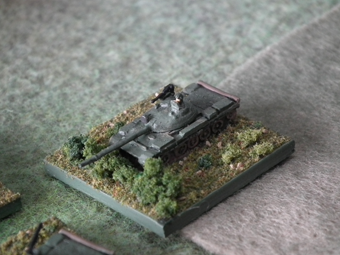
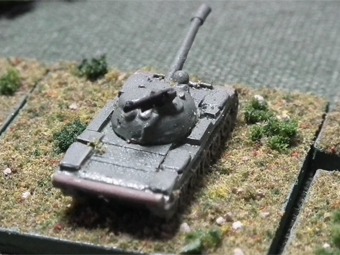
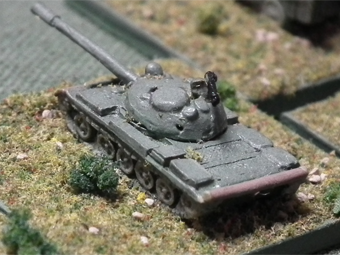
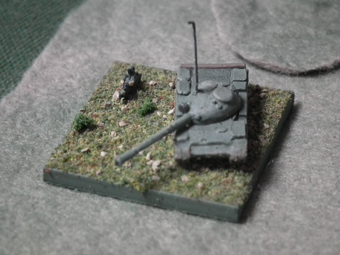
The next two shots show a non-commander's vehicle, identified by the presence of a heavy machine gun on top of the turret as a T-55A. The H&R T-55 doesn't come with an AA gun, so the 12.7 mm AA gun has been added; almost all my T-55s are like this. (The newly remastered H%R T-55 is also a plain T-55, not a T-55A, and thus without a gun, unlike their new T-54A). A battalion commander's vehicle really ought to be a T-55AK, rather than a vanilla T-55A. However, for a T-55AK, adding an AA HMG is probably a mistake, as most photos I have seen of tanks that are ostensibly T-55AKs lack the gun: what they do have as an extra long aerial that telescopes down into a carrying tube on top of the turret, plus extra radio gear inside. A tank regimental commander would also ride a T-55AK, although I tend to model Tank RHQ stands as being carried in APCs, as the vast majority of the personnel in the element were not riding in tanks. Nonetheless, I have a tank-based element for each RHQ as well, so I can go either way.
While Czechoslovakia needed to produce only 144 T-55AKs for its own forces, it made over a thousand more for export; Czechoslovakian vehicles were found in large quantities in the forces of Poland, East Germany, Egypt, Syria, etc. The brown cylindrical thing at the back of the tank is a log of wood. This was used as an unditching beam; if the tank got stuck in deep mud, the log could be passed under the tracks in an attempt to free the tank by giving it something solid to ride over.
The final picture shows the tank version of my 3rd Division's 33rd Tank Regiment regimental HQ stand, i.e. a T-55AK, with its fording periscope raised, and a dispatch rider on a motorbike alongside ready to take orders when operating under radio silence conditions. A periscope was required when deep fording rivers so you could see where you were going (no GPS back then, and inertial navigation systems were unreliable...), but it might also be used on dry land to peer over obstacles.
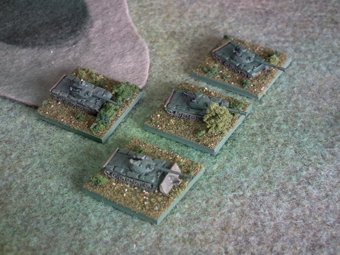
A T-55 company from a Motor Rifle tank battalion, with the BHQ stand behind. You can tell this company is from a motor rifle tank battalion, because it is three stands-strong, rather than two. Tank companies from tank regiments in real life comprised 3 platoons each of three vehicles, plus the company commander's vehicle, for 10 vehicles in total; three companies plus the commander's T-55AK made 31 vehicles. MSH compromises on the 3-(weak) platoon company formation by making it just 2 stands-strong.
In the 1969 Czechoslovakian military reorganization, Motor Rifle
Divisions gained an independent tank battalion. The three companies of
this battalion were evidently usually split up amongst the 3 motor rifle
battalions, because this organization became permanent in the next reoorganization that each division subsequently went through, starting with the 20th Division in 1974. Being a
second-echelon formation, the 3rd Motor Rifle Division only reorganized this way in 1979, after which each motor rifle tank battalion had 40 vehicles, as each platoon was now 4-strong, not 3, which translates to 3 stand-strong table-top companies. One of these
H&R vehicles has a large dozer attached. Czechoslovakia used a variety
of specialist mine-ploughs as well as more general dozer blades like
this one. A plain non-specialized dozer blade allows me to easily ignore its
presence if I don't want to pay for mine ploughs or mine rollers in a points-based game (I think I only have one, or maybe 2, examples of the H&R T-55 model with mine rollers, because of this lack of "morphability").
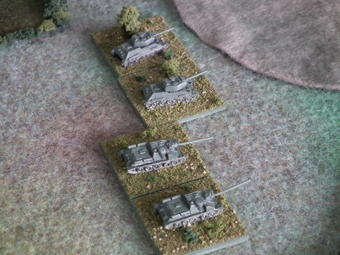
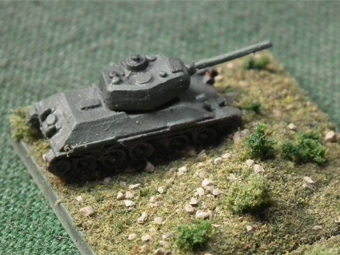
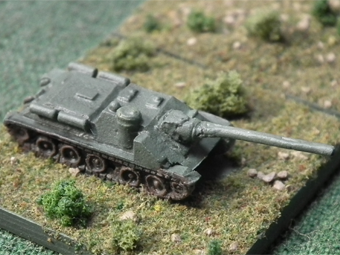
On the left are a couple of tank platoons equipped with T-34/85s and SD-100s (as
the Czechoslovkians called the SU-100), respectively. The T-34/85 was withdrawn
from the front line during the 60s, and disappeared from 2nd-echelon units during the early 70s. It was retained in storage, however, for use in reserve
formations all the way through till 1988. In addition, training units used it actively much longer than field units; in the mid-80s one active unit employed it alongside brand-new T-72Ms! In game terms T-34s are entirely usless frontally against modern armour (i.e. anything post 1950...), but can be usefully employed on flank marches where they are less likely to have to face these things frontally. I rather like this H&R model - the gun is nice and slim; unfortunately, it just makes those of the supporting SD-100s look far too thick. This particular example is mounted on a 3-d textured base. I should make more of my bases like this, as it looks good; alas, it is also quite a bit more effort than simply plonking the tank down on a regular base! My standard bases are 30 mm square, and made from 2 mm thick cardboard.
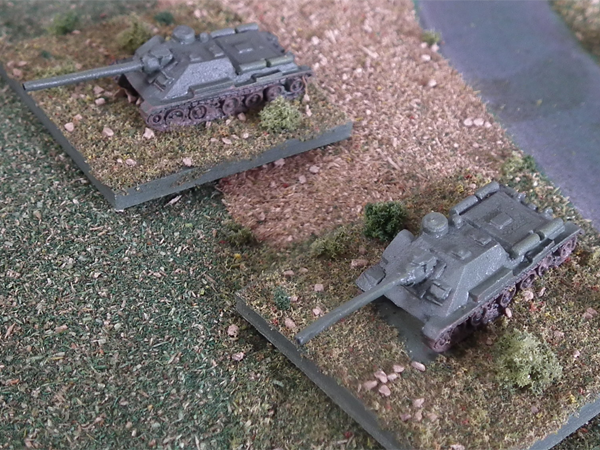
The SD-100 was kept on slightly longer than the T-34 in active service: some sources indicate they were still being used in the 1970s in the regimental artillery battery allocated to each Motor Rifle Battalion prior to the reorganization brought about by the introduction of the BVP-1 (other sources indicate, however, that these units had more conventional towed howitzers; perhaps equipment varied by regiment). SD-100s simply look cool, and that's often a good enough reason for me to field them! The SD-100 is of course, like the T-34, a WW2-era design. Alas I can't use these with my WW2 Czechoslovakian 1st Corps, as they used the SU-85, albeit in limited numbers, alongside their T-34s rather than the SU-100: they initially had T-34/76s before moving to T-34/85s. The Czechoslovakians kept manufacturing the SD-100 for quite some time, with production only ceasing in 1957.
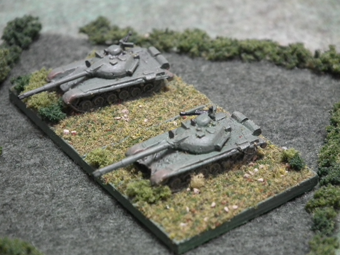
Here's a company of T-72s from the 3rd Division's tank regiment, the 33rd. The 3rd Division was the only Czechoslovkian Motor Rifle Division to operate the T-72: for the four year period 1978 to 1982, its 33rd Tank Regiment had two companies equipped with early-model T-72s (note the lack of side skirts covering the tracks). In 1982 they were transferred to the Eastern Front's 14th Division in what is now Slovakia, and mostly used for training purposes, it appears.
These early model tanks were imported from the Soviet Union, mostly for evaluation purposes (the Poles similarly got a a small number at the same time). They lacked the laser range finding gear that the T-72s domestically produced in the 1980s had, although that isn't a crippling limitation in game terms, since you have to be on a hill anyway to take advantage of the 3" of extra range the laser range finder gives you (21" rather than 18"; 18" being the standard spotting distance). They do however have several advantages over the T-55 that the rest of the regiment is equipped with: a +1 better attack factor, a +1 better defence factor (but no better against ATGWs; that doesn't happen until the T72M1 comes along in the second half of the 80s, turning a meagre 2 into a still sub-par 3), and an 18" range rather than 15" range. Alas, their increased speed is of little use, since the rest of their battalion has the slower T-55. The 18" range is more important than it might first appear, due to the standard spotting distance being 18" as noted above; indeed, the only difference in MSH between a T-55 and a T-62 is the T-62 gets an 18" range. In a game where, unlike WW2 Spearhead, elements have just a single range band, this can lead to an entire battalion stuck at 16" range being unable to shoot at all while it is being targeted at maximum effectiveness by the enemy if they have an 18" range.
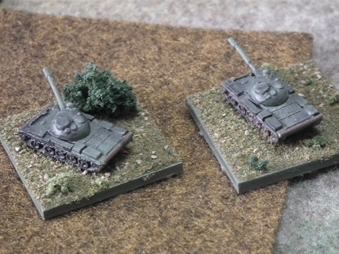
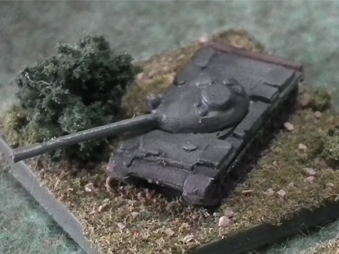
Above are some actual T-55s, as opposed to T-55As, easily recognizable as they lack an AA gun. The H&R T-55 doesn't (at the moment anyway) actually come with an AA gun; I've had to add them to mine. Why the original real-life T-55 was produced like this is unclear to me, because the T-54 model it replaced had one, and the need was clearly felt, since this was one of the main reasons for the introduction of the T-55A!
In game terms, the presence of an AA gun isn't the only difference between the
two, however. The original T-55 has a one worse attack factor (8 compared to
9), presumably reflecting the poorer ammunition available during the 50s and 60s: it wasn't until the late 60s, when the T-55A was introduced, that the new high-velocity discarding sabot ammunition types became available. This really shouldn't affect older T-55s still around in the 70s or 80s, since they would have had access to this ammunition, but it's not hard to rationalize away as reflecting the poorer training of recently conscripted men in the reservist formations that would have used such older non-upgraded tanks. Czechoslovkia had five such mobilization-only Divisions in the 70s/80s (2 Tank, 3 Motor Rifle), plus various other mobilization-only formations such as artillery and engineering battalions.
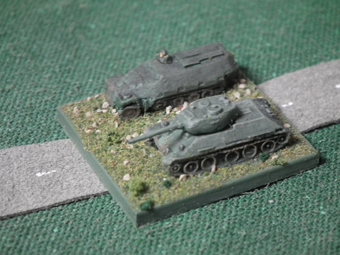
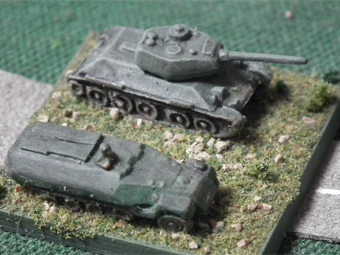
These two shots showing a T-34/85 and an OT-810 on the same base are for the "tank-version" of the regimental HQ stand of my mobilization-only tank regiment, when playing it as equipped with T-34s and SD-100s instead of T-55s. Unlike in NATO armies, in which the HQs of tank brigades tended to have a platoon of tanks attached to them, Warsaw Pact Tank regimental HQs had just a single tank, as the commander's personal vehicle. All the other officers rode in less well armoured APCs. Given so many of the command functions of the stand are tied in to those officers, and not the commander (e.g. calling in artillery), it is entirely legitimate to model the stand as being effectively an APC rather than, as modelled here, a tank stand, making it more vulnerable (in MSH, no command stands shoot, so the disparate offensive capabilities of tanks and APCs doesn't come into play).
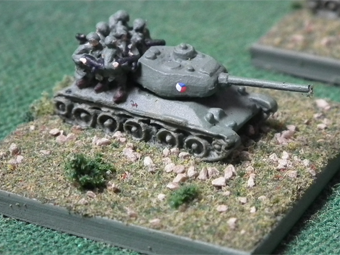

Here we move back further in time. These T-34/85s belong to my WW2 Czechoslovakian 1st Corps; the Corps, like most Soviet-supplied formations, lacked the same level of transport capabilities as the Western allies possessed, leading to the men frequently hitching rides on the tanks. The greater distances to be traversed no doubt contributed as well. The Corp's tanks carried the Czechoslovakian roundel (or, at least, they did so in May 1945; whether they did prior to this I haven't been able to find out), but in a rather strange orientation, with the blue pointing directly upwards, instead of, as usual, the 2 o'clock position (or 10 o'clock if on the right side of a vehicle). The Corps has one complete Tank Brigade, the 1st; one of the 2nd Brigade's battalions was also a tank battalion.
Back to my photos top page.